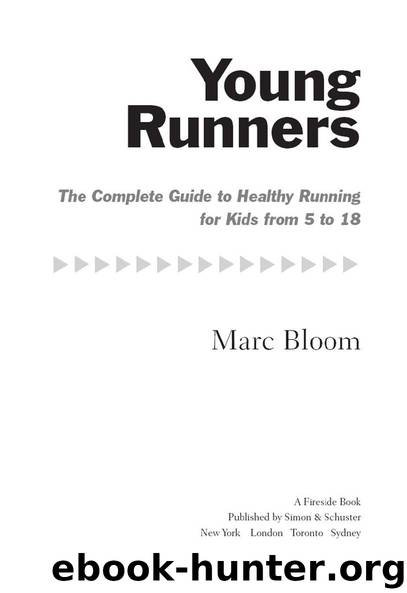Young Runners by Marc Bloom

Author:Marc Bloom
Language: eng
Format: epub
Publisher: Simon and Schuster
Published: 2009-07-15T00:00:00+00:00
More evidence of the efficacy of Callie’s approach comes from a parent, Jeanne Canna, when she picks up her sixth-grade boy from practice. Her older son, Justin, now a high school sophomore, ran for IS 30 for three years. His mom says, “It was absolutely great. He has identified himself as a runner and because of that stays away from smoking, drugs, alcohol. He feels no pressure because he considers himself an athlete.”
If anyone wonders if Callie’s style is too soft—what about those fast times a 13-year-old should aspire to?—the IS 30 trophy case is filled to capacity. Experts believe that good values make winners. “The irony,” says Dr. Brenda Armstrong, of the Durham Striders youth track squad, “is if you stress healthy ideas and good values the trophies will come naturally. It’s the winning attitude. Athletics is a veiled way to empower children to take control of their lives.”
GIRLS CHOOSE FUN OVER PRESSURE
Research is beginning to affirm what coaches learn on the job. A 2007 study of physical activity in girls by the Tucker Center for Research on Girls and Women in Sport at the University of Minnesota found that girls enjoy activity when it’s based on effort, learning, peer support, and equal treatment, and they shun activity that is “ego-oriented,” favors a few, encourages competition among team members, and is generally judgmental. For girls, the study found, adult leaders and role models—parents, teachers and coaches—are critical sources of motivation and satisfaction. The study concluded that “fun is the most prevalent reason girls give for participating in sport,” and that enjoyment is the strongest predictor of continued involvement.
Likewise, a six-year study of middle school girls funded by the National Heart, Lung and Blood Institute and published in the American Journal of Preventive Medicine in 2008 found that social milieu, enjoyment, and a youngster’s sense of competence were “huge drivers” in making girls active in healthy forms of exercise. According to the study leader, Russ Pate, Ph.D., professor of exercise science at the University of South Carolina and perhaps the nation’s foremost authority on middle school children and exercise, this was the first large-scale study to use an objective measurement of activity. “Instead of a self-report in which there’s a risk that kids will tell you what you want to hear,” says Pate, “we used state-of-the-art accelerometers, which are motion sensors to measure activity.”
The study, the Trial of Activity in Adolescent Girls, or TAAG, was conducted in thirty-six middle schools in six states in geographically diverse areas in which more than 3,000 girls in sixth through eighth grades were assessed. Half the schools were control groups and half were given physical activity interventions. The interventions included enhancements in PE classes and establishing partnerships with community organiza tions that provided after-school activity to ensure continuity. “If you can change the environment in substantive ways,” says Pate, a former national-caliber distance runner who competed in three Olympic trials marathons, “it will influence kids’ behavior.”
Activities included walking, running, and various forms of dance.
Download
This site does not store any files on its server. We only index and link to content provided by other sites. Please contact the content providers to delete copyright contents if any and email us, we'll remove relevant links or contents immediately.
Bodyweight Strength Training by Jay Cardiello(7184)
Tools of Titans by Timothy Ferriss(6945)
Born to Run: by Christopher McDougall(6259)
Inner Engineering: A Yogi's Guide to Joy by Sadhguru(5894)
Asking the Right Questions: A Guide to Critical Thinking by M. Neil Browne & Stuart M. Keeley(4574)
The Fat Loss Plan by Joe Wicks(4237)
Bodyweight Strength Training Anatomy by Bret Contreras(4058)
Yoga Anatomy by Kaminoff Leslie(3700)
Science and Development of Muscle Hypertrophy by Brad Schoenfeld(3577)
Dynamic Alignment Through Imagery by Eric Franklin(3488)
The Four-Pack Revolution by Chael Sonnen & Ryan Parsons(3483)
ACSM's Complete Guide to Fitness & Health by ACSM(3467)
Yoga Anatomy by Leslie Kaminoff & Amy Matthews(3394)
Bodyweight Strength Training: 12 Weeks to Build Muscle and Burn Fat by Jay Cardiello(3350)
The Ultimate Bodybuilding Cookbook by Kendall Lou Schmidt(3317)
Exercise Technique Manual for Resistance Training by National Strength & Conditioning Association(3291)
Nutrition for Sport, Exercise, and Health by Spano Marie & Kruskall Laura & Thomas D. Travis(3234)
Nutrition for Sport, Exercise, and Health by Marie Spano & Laura Kruskall & D. Travis Thomas(3231)
Yoga Therapy by Mark Stephens(3222)
